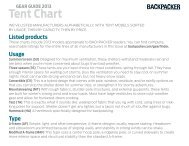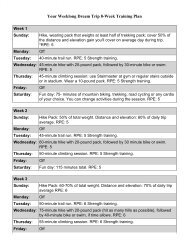BP Get Out More PDF prep
BP Get Out More PDF prep
BP Get Out More PDF prep
You also want an ePaper? Increase the reach of your titles
YUMPU automatically turns print PDFs into web optimized ePapers that Google loves.
BALL TOSS<br />
Stand on one foot with your knee slightly bent and face a partner who also<br />
is standing on one foot. Toss a ball back and forth, catching it in both hands.<br />
For balance novices: Skip the ball toss and don’t add spinal rotation<br />
to the single-leg stance with chop. Keep both feet flat on the floor for the<br />
clock leg reach and single-leg stance with chop. Stop if you start to feel<br />
uncomfortable.<br />
For balance pros: Try lifting yourself onto your toes during the leg<br />
reach, single-leg stance, and ball toss exercises. Stand on a less firm surface,<br />
like foam or sand. Hold a child’s ball, medicine ball, or hand weights. Or,<br />
if you aren’t holding anything, flap your arms to try to unbalance yourself.<br />
Flexibility Training<br />
Whether they’re used to hoist your bear bag or pull you over a boulder,<br />
flexible muscles will do the job, without pulling or straining. All hikers,<br />
no matter what their level of experience, should stretch at least three times<br />
a week at home and daily on the trail. Save your flexibility training for the<br />
end of a workout, when your muscles are warm. Hold each stretch for<br />
15 to 30 seconds and repeat two to five times.<br />
ACHILLES TENDONS/<br />
CALVES (RIGHT)<br />
A: Stand facing a wall, and<br />
press your hands against the wall<br />
so that your arms are straight and<br />
at shoulder height. Extend one<br />
foot behind you, with your heel<br />
on the ground and your toes facing<br />
forward. B: Bend your front<br />
leg while keeping your back leg<br />
straight. Hold. Then, with your<br />
front leg still bent, bend your<br />
back leg, keeping your heel on the<br />
ground (Tip: Move your back foot<br />
a little forward). Hold. Relax and<br />
repeat on the other side.<br />
BACK<br />
A<br />
B<br />
<strong>Get</strong> down on all fours with your hands directly under your shoulders<br />
and your knees directly under your hips. Inhale slowly, then tuck in your<br />
chin, arch your back, and tuck your hips under slightly. Hold. If you’re<br />
stretching correctly, your back will be in an asymmetrical arch, like a<br />
Halloween cat. Then exhale and relax your back without relaxing your abs;<br />
at the same time, lift your chin to look ahead of you (not up) and lift your<br />
buttocks slightly. Repeat, moving slowly and carefully.<br />
HAMSTRINGS<br />
Stand in front of a knee-high, sturdy object. Place the heel of one foot<br />
on the object, standing tall and keeping both knees straight. If you feel any<br />
discomfort, look for a lower object. Lean your torso forward (not down!)<br />
and hold. Switch legs and repeat.<br />
QUADRICEPS<br />
Stand a foot or two away from and with your back to a chair back or<br />
desk. Using your right leg, bend your knee and lift your leg behind you so<br />
that you can place the top of your foot on the chair back or desk. Tighten<br />
your buttocks and extend your pelvis slightly forward. Hold, then do the<br />
same with your left leg.<br />
Troubleshooting<br />
Move slowly until you know the limits of your comfortable and pain-free<br />
range of motion. If something hurts, don’t do it, or modify the routine. Dr.<br />
Musnick also advises:<br />
If you have knee problems: Stick to flat surfaces and avoid stepping<br />
downhill when doing lunges or other stepping exercises. Don’t run downhill<br />
or descend stairs as a part of a workout. Both lunges and squats will<br />
strengthen the fronts of your thighs and your buttocks, which can help take<br />
pressure off your knees.<br />
If you have back problems: Avoid rotational movements unless your<br />
doctor has approved them. Take extra care not to twist your back if you use<br />
a cross-country ski machine. Lift your backpack safely by lowering yourself<br />
to one knee to swing the pack onto your back; better yet, have a hiking<br />
partner hoist the pack onto your back. Always keep your abdominal muscles<br />
tightened for support. Do plenty of balance training to develop strong<br />
abs, since they support your back muscles.<br />
If you have ankle problems: Strengthen them with one-leg balances,<br />
gradually moving to softer surfaces to add to the challenge.<br />
If you have shoulder problems: Add strengtheners such as assisted<br />
dips, assisted pull-ups (standing on a chair or having a friend support your<br />
lower body), and modified push-ups on your knees (supporting your<br />
weight on your hands and knees instead of on your hands and toes).<br />
28 GET OUT MORE!<br />
WWW.BACKPACKER.COM 29






